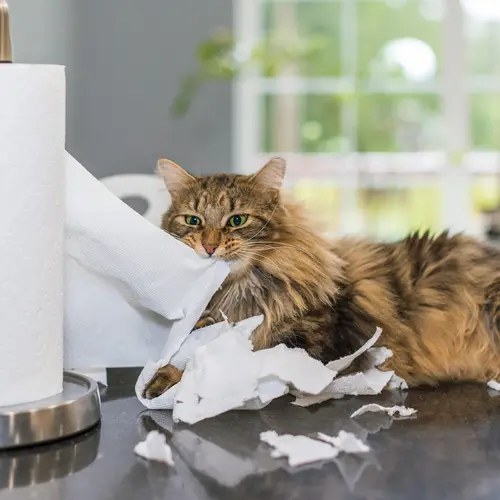When you adopt a pet, you have the responsibility of ensuring they are well cared for both physically and mentally. Many people consider cats to be independent creatures, but they still need our help to thrive and live long, healthy lives.
Go for a Walk
You may not think about putting your cat on a leash to go for a walk outside, but with some practice, it is possible to leash train a cat. Going for a walk provides exercise and mental stimulation for your cat. Keep in mind that a cat can wiggle out of a collar very easily, so you should purchase a harness instead that secures around your cat’s body.
It is easiest to leash train a young kitten so they grow accustomed to the leash early in life. Start slowly, first allowing your cat to wear the harness without the leash. Progress the training by attaching the leash and allowing your cat to explore your home and then your yard when you feel like they're ready.
Be aware of any dogs that live in your neighborhood and try to plan walks for when others aren’t out with their pets. Stay aware of your surroundings, and if you see a dog ahead of you, pick up your cat and carry them until you’re a safe distance away from the dog.
Once you get back home, remove the leash right away. You should never leave your cat tied to anything by their leash unless you are within eyesight and supervising their exploration.
Windows
For cats, being able to look outside is mentally stimulating and provides all-day entertainment. If you have blinds or other window coverings that prevent your cat from seeing out, consider dedicating one window to your cat’s mental health.
Pull the blinds up far enough that your cat can sit on the windowsill. You can even install a cat perch that allows them more space to stretch out and relax while they see what's going on outside. This is especially important if you work full-time away from home so your cat isn’t bored all day.
Healthy Weight
One way to ensure your cat’s mental and physical health is to help them maintain a healthy weight. Talk to your veterinarian about what your cat should weigh and what cat food is best for their overall health. Just as a healthy diet helps us feel better, it helps your cat, too.
If your cat is overweight, dedicate 15-20 minutes a day to playing with your cat in ways that keep them highly active. Ideas for play include:
- Chasing one another or playing peek-a-boo
- Playing hide-and-seek
- Using a laser pointer
- Feather toys
- Paper bags and boxes for exploring
Cat Trees
Many pet stores carry cat perches, condos, and trees that give your cat vertical space to explore. These structures are usually multi-level towers with places to sit in and on. They may be made of carpet and other materials that encourage your cat to dig their claws in to climb and scratch.
The desire to sharpen their claws is natural to cats, and a perch or tree can help save your other furniture from their claws. If possible, have at least two towers in different rooms of your house. Consider putting them by windows and rearranging them periodically so your cat receives additional mental stimulation from being in different areas of your home.
Switch Out Toys
You may give your cat small mouse toys, balls, and feather toys to play with when you’re not at home. Keep a collection and rotate the available toys every week so your cat consistently has something new to play with. Be sure to store any string toys away when you’re not supervising playtime so your cat doesn’t get tangled up.
Offer Treats
You can offer treats to your cat, but consider ways that you can encourage them to earn the treats through activity. By hiding treats inside toys, they'll feel the reward of working for their treat and satisfy their instinct to hunt for food.
You can purchase treat toys from a pet store or make your own at home. Add treats to toilet paper rolls and fold the ends down so your cat has to work to open the roll and get their treats out. You can even poke holes in the sides so they can smell the treats better.
You can put treats inside toilet paper rolls with holes big enough for the treats to fit through, securing the ends so they won’t open. Your cat has to bat the roll around until the treats fall out of the holes.
Keep in mind that only 10-15% of your cat’s diet should consist of treats. Cat treats are usually higher in calories and may not meet their nutritional needs in the same way that dry or wet food does. Talk to your vet about the best treats for your cat’s health.


